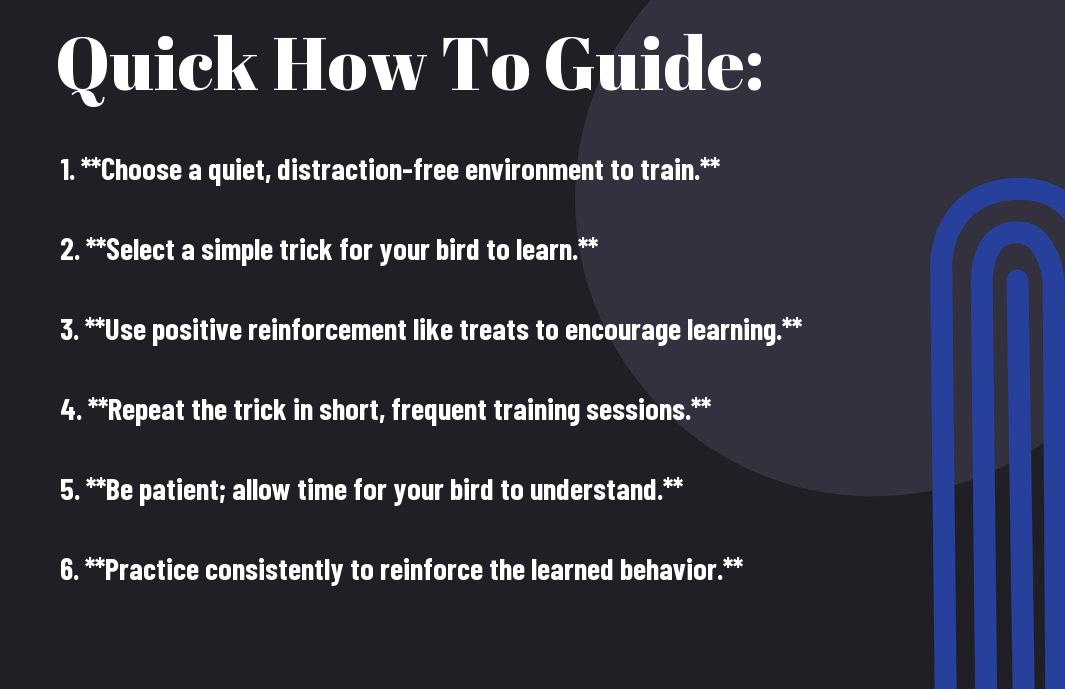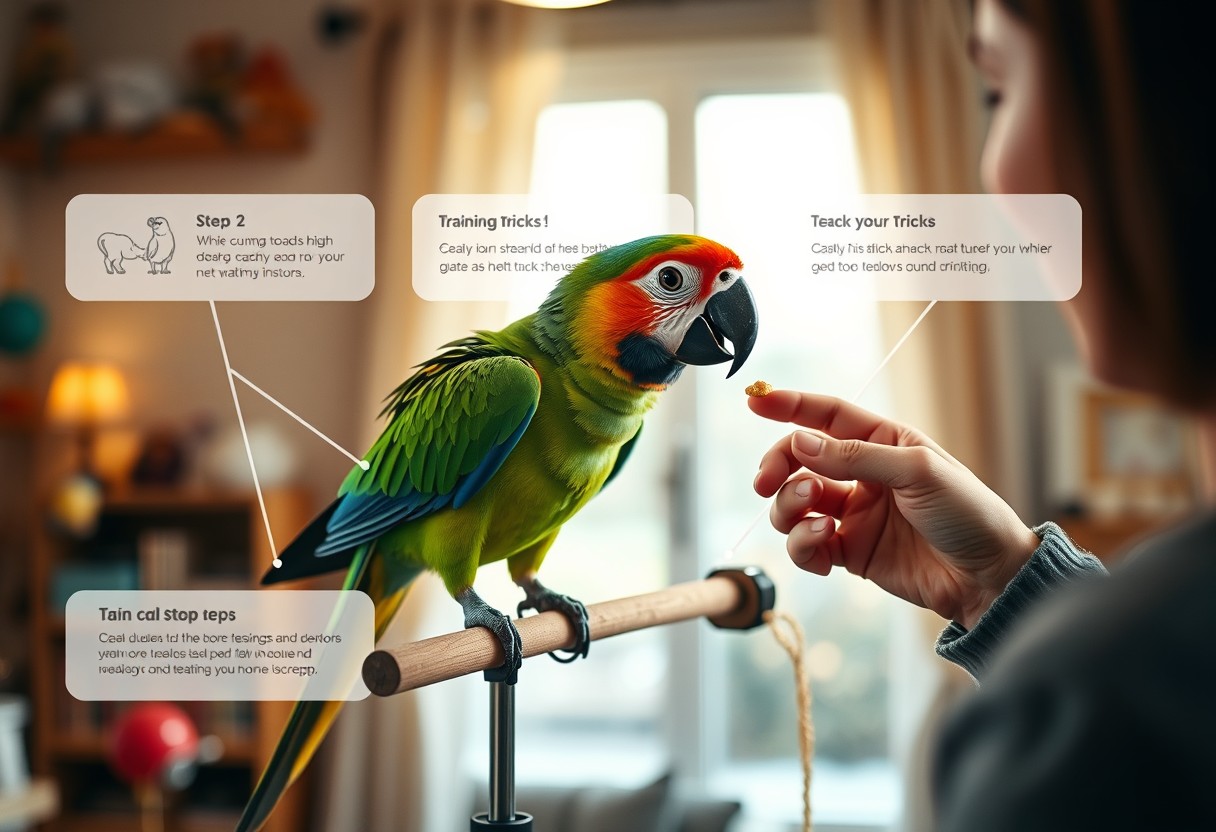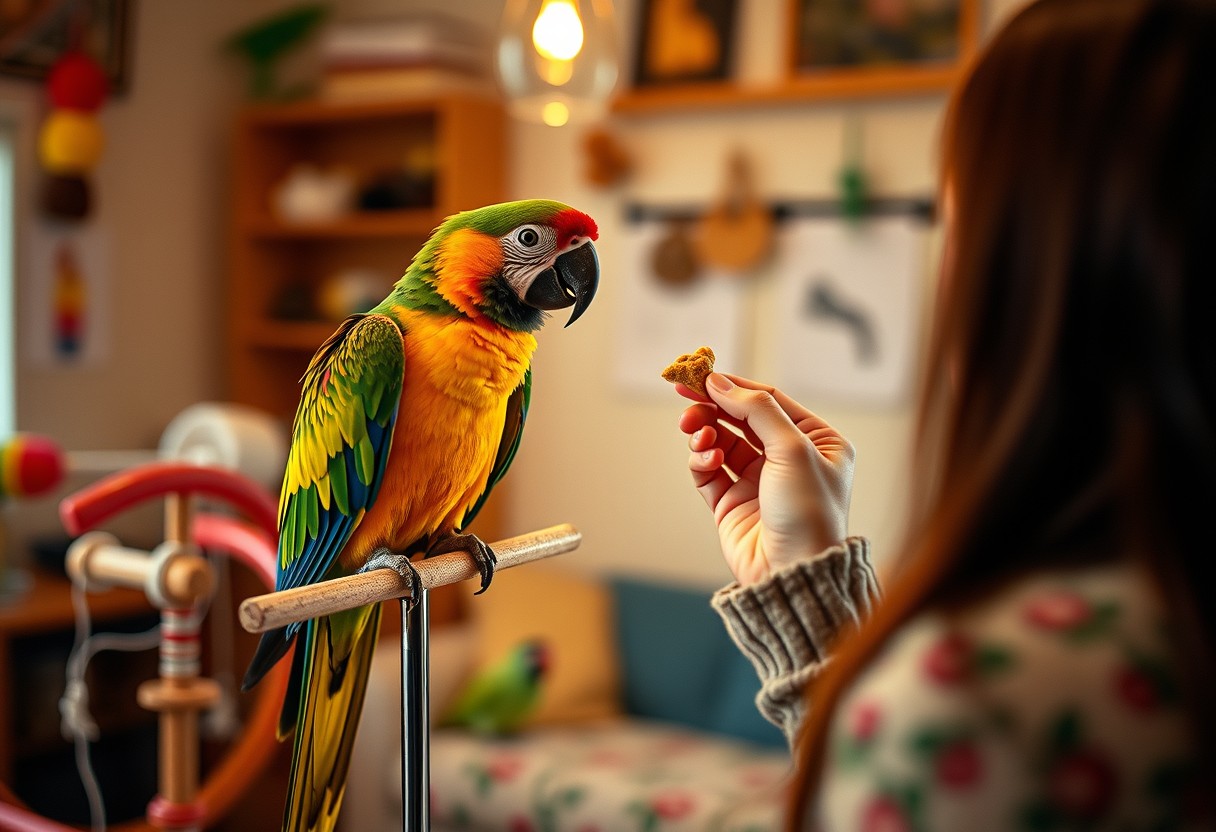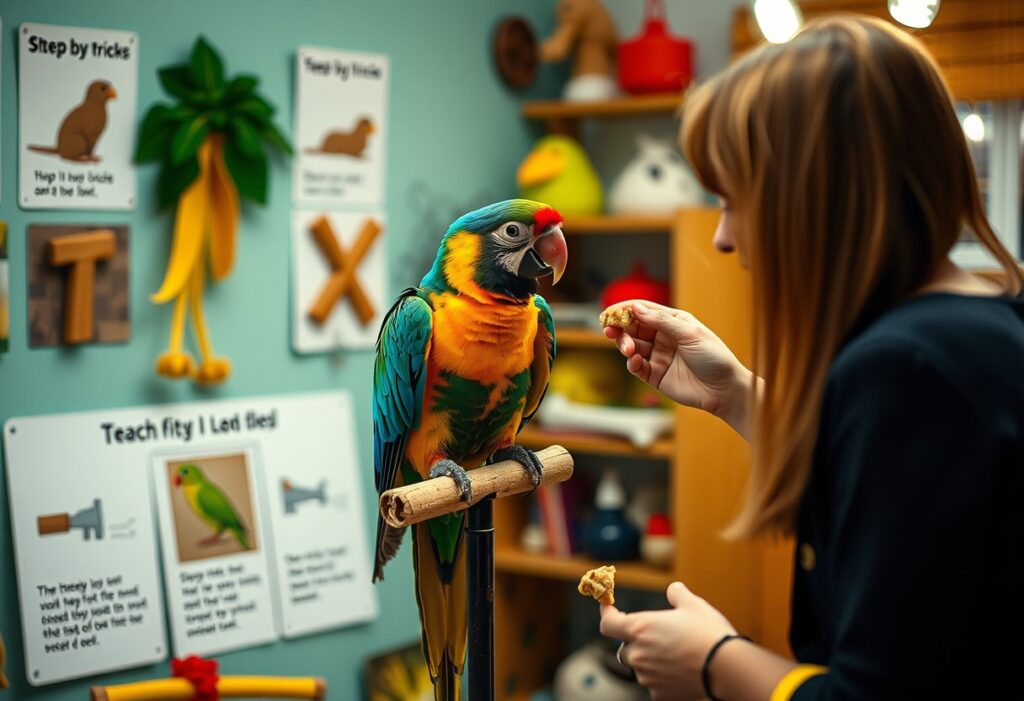This comprehensive guide will equip you with all the knowledge you need to effectively teach your bird new tricks. With the right techniques and patience, you can transform your feathered friend into an engaging performer while enhancing your bond. We will cover step-by-step methods for training your bird, focusing on positive reinforcement to ensure a rewarding experience for both you and your pet. Do not forget, safety is crucial; avoid using any materials or methods that could harm your bird, and always prioritize their well-being throughout the training process.


Understanding Your Bird
As a bird owner, it’s crucial that you take the time to fully understand your pet. Each bird species is unique, and deficiencies or strengths in their learning ability can stem from various factors. By recognizing these elements, you can tailor your training approach to meet your bird’s specific needs.
Factors Influencing Learning Ability
On your journey to teach your bird new tricks, it’s important to consider several influences that affect their ability to learn. Each bird possesses an array of different characteristics that contribute to their learning process, including:
- Species – Different species have varying natural instincts and cognitive abilities.
- Age – Younger birds often learn more quickly than older ones.
- Environment – A peaceful and engaging environment can facilitate learning.
- Bonding – A strong bond with you makes your bird more open to learning.
This understanding can help you craft a more effective training regimen that aligns with your bird’s individual needs.
Tips for Building Trust with Your Bird
With patience and dedication, building trust with your bird is a vital step in making training successful. Establishing a trusting relationship will encourage your bird to engage in learning activities and new tricks. Here are some effective strategies you can implement:
- Spend time together – Regularly interact with your bird outside of training sessions.
- Positive reinforcement – Use treats or praise to reward good behaviors.
- Consistent routine – Maintain a consistent training schedule to develop predictability.
- Gentle handling – Always handle your bird gently to foster a sense of safety.
Recognizing the importance of trust in your relationship with your bird will set the foundation for effective training.
It’s important to remember that trust is built over time and requires a gentle touch. By gradually allowing your bird to become more familiar and comfortable with you, you encourage a nurturing environment. You should always provide a positive and safe experience, as this reinforces your bird’s confidence around you. When you focus on these trust-building practices:
- Patience is key – Avoid rushing the process; take your time.
- Watch for body language – Pay attention to how your bird reacts during interactions.
- Use soft tones – Speak to your bird softly to create a calming atmosphere.
Recognizing these aspects of trust will significantly enhance your ability to teach your bird new tricks.
Preparing for Training
One of the most crucial aspects of successfully training your bird is adequately preparing for the sessions ahead. This preparation starts with creating the right environment, as it can significantly impact your bird’s ability to focus and learn. By ensuring a calm, quiet, and distraction-free space, you set the stage for effective training. Note, your bird is sensitive to its surroundings, and a chaotic environment can lead to stress, making it harder for your feathered friend to absorb new information. Choose a room that is away from loud noises and other animals, and consider using blankets or curtains to create a cozy, private space.
Choosing the Right Environment
Any environment that feels safe and secure for your bird will encourage its willingness to engage in training. The space should ideally be well-lit but not too bright, as harsh lights may startle your bird. Additionally, placing your bird’s cage in the training room can provide a sense of familiarity. You want to create a setting that allows for positive experiences, so using a comfortable perch or a training stand can help your bird feel at ease while it learns new tricks. Keeping your training sessions short and sweet will also help your bird absorb the information without feeling overwhelmed.
Selecting Appropriate Training Tools
Clearly, using the right tools can greatly enhance your training experience and yield better results. One of the most effective training aids is a target stick, which encourages your bird to move towards a specific point. It’s important to have quality treats on hand that are healthy and appealing to your bird, as this will motivate them to participate. Additionally, consider using a clicker as a way to positively reinforce good behavior. The sound of the clicker instantly lets your bird know it has done the right thing, making it easier to connect the action with the reward.
This selection of tools should be comfortable and manageable for you and your bird. Avoid using any tools that could cause harm or discomfort, such as tightly fitting harnesses or sharp items. Instead, focus on items that promote a positive training experience, reinforcing the bond between you and your bird. Note, training should be an enjoyable activity for both you and your feathered companion, so you want to ensure that your tools enhance this fun process rather than complicate it.
Teaching New Tricks
Once again, teaching your bird new tricks is not only an engaging way to bond with your feathered friend, but it also promotes mental stimulation and can help prevent behavioral issues. The key to success lies in breaking down the tricks into manageable parts that your bird can learn step by step. Each bird is unique, and their ability to learn new behaviors will vary, so patience and practice are imperative as you guide them through the training process.
How-to Break Down the Tricks
You should start by defining the specific trick you want to teach your bird. Next, break this trick into smaller, more digestible components. For example, if you want your bird to learn to “spin,” you can start by encouraging it to turn its head in a circular motion first. Once your bird seems comfortable performing the initial component, gradually introduce the next part until the full trick is achieved. This step-by-step method will not only make the training process smoother for you but also less overwhelming for your bird.
How-to Use Positive Reinforcement
Now, positive reinforcement is a powerful tool in bird training. Utilizing treats, verbal praise, or gentle petting when your bird successfully performs a part of the trick encourages repetition of that behavior. Make sure to reward your bird immediately after it completes the action so it connects the reward with the desired behavior. Over time, your bird will associate the action with positive outcomes, motivating it to keep performing and learning new tricks.
Break your training sessions into short, fun bursts. Birds have short attention spans, and keeping the sessions brief will help maintain their interest and enthusiasm. Over time, as your bird becomes more proficient, you can gradually increase the complexity of the tricks and reduce the frequency of rewards.
Tips for Maintaining Consistency
On your journey of teaching new tricks, consistency is paramount. You will want to establish a regular training schedule, ideally at the same time each day, so your bird anticipates the opportunity to learn. When practicing any trick, be sure to use the same commands and cues each time, as this helps your bird grasp what you expect from it. Here are some tips to help you maintain consistency:
- Establish a structured **training session** routine.
- Use the same **cues and commands** for each trick.
- Limit the number of **distractions** in the environment during training.
Any lack of consistency can lead to confusion in your bird, which could hinder the training process or even result in **frustration**. It’s crucial to remember that every bird learns at its own pace, and maintaining a steady approach to training can keep the learning process enjoyable for both of you.
Maintaining your training sessions consistently can elevate your bird’s learning experience. To reinforce your commitment, be prepared to modify the intensity and duration of your training sessions based on how well your bird is responding. Here are a few more points to consider:
- Keep track of your bird’s **progress** with each new trick.
- Adapt training methods based on your bird’s **individual needs**.
- Pay attention to your bird’s **mood and energy levels** during sessions.
Any changes to your routine can significantly impact how your bird perceives the training process, so strive to remain committed to the consistency of your approach!

Troubleshooting Common Issues
Keep in mind that while teaching your bird new tricks can be an enjoyable experience, you may encounter some challenges along the way. It’s important to understand the obstacles that could be hindering your bird’s progress to ensure a smooth training process. When your bird doesn’t seem to be picking up tricks as quickly as you hoped, consider the following factors:
Factors That May Hinder Progress
The first step is to evaluate the environment in which you’re training. External stimuli such as loud noises or distractions can prevent your bird from focusing. Moreover, your bird’s emotional state plays a significant role in its learning abilities. If your bird is stressed, frightened, or unwell, it is less likely to be receptive to training.
- Distractions in the environment
- Stress or discomfort in your bird
- Health issues that may affect concentration
- Inconsistent training sessions
Knowing these factors can help you create a more conducive learning environment for your bird.
The good news is that there are strategies you can employ to maintain your bird’s enthusiasm during the training process. One effective strategy is to vary the tricks you’re teaching, allowing your bird to explore different skills while keeping training fresh. Additionally, incorporating play and rewards into the mix can serve as powerful motivators.
Tips for Keeping Your Bird Engaged
- Vary the tricks and training methods
- Use positive reinforcement effectively
- Engage with interactive toys
- Maintain short training sessions
Recognizing the need for variety is key in sustaining your bird’s interest in training. By interspersing different tricks with fun activities, you not only keep your bird engaged but also help cement the new skills learned. Keeping training sessions short—usually around 5 to 10 minutes—prevents fatigue and maintains your bird’s concentration throughout.
Understanding your bird’s unique personality is crucial in tailoring your training methods. Just like humans, birds have their preferences and limitations. Some birds thrive on **verbal cues**, while others might prefer **visual signals**. Experiment with different approaches to discover what resonates with your bird. A well-rounded training program will allow both of you to enjoy the process together, reinforcing your bond and ensuring that your bird looks forward to each session. Recognizing these aspects will ultimately lead to a more fulfilling training experience for you and your feathered friend.
Summing up
With this in mind, teaching your bird new tricks can be a rewarding experience that strengthens the bond between you and your feathered friend. By following a structured, step-by-step approach—starting with basic commands and gradually advancing to more complex tricks—you can ensure that your bird not only learns but also enjoys the process. Consistency, patience, and positive reinforcement are key components in this journey, allowing you to celebrate small victories and maintain your bird’s enthusiasm for learning.
By incorporating these techniques into your training routine, you’ll foster a stimulating environment for your bird, encouraging mental exercise and preventing boredom. Remember to be attentive to your bird’s reactions, adjusting your methods as needed to suit its temperament and learning style. Ultimately, the time and effort you invest in teaching your bird new tricks will yield a happier, healthier, and more engaged companion in your home.
Q: What are the basic requirements for teaching my bird new tricks?
A: To effectively teach your bird new tricks, it’s important to create a suitable environment and gather imperative tools. First, ensure that you have a quiet space free from distractions. Next, gather some high-value treats that your bird enjoys, as these will be used as rewards during training. Additionally, have a clicker or a verbal cue ready for marking desired behaviors. It’s also vital to spend time bonding with your bird before starting training, as a trusting relationship makes the learning process smoother.
Q: How do I choose the right trick to start with?
A: Selecting the appropriate trick for your bird to learn is crucial to the training process. Start with simple tricks that match your bird’s natural capabilities. For example, small birds like budgies can learn to step up onto a perch or your finger, while larger birds might enjoy learning to spin or wave. Observe your bird’s behavior and interests to find a trick that engages them. Begin with one trick at a time, as tackling too many things at once can lead to frustration for both you and your feathered friend.
Q: What can I do if my bird isn’t responding to training?
A: If your bird isn’t responding to training as expected, there are several strategies you can try. First, ensure you are using positive reinforcement and are consistent with your cues and rewards. If your bird seems disinterested, consider reevaluating the chosen trick or the type of reward you’re using. Additionally, make sure the training sessions are short and fun to prevent your bird from becoming bored or overwhelmed. Take breaks and try again later, keeping the sessions playful and engaging. Remember that patience is key; every bird learns at its own pace.











